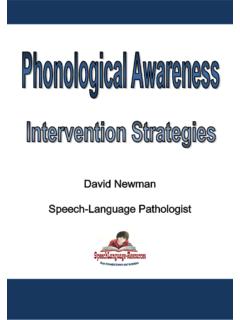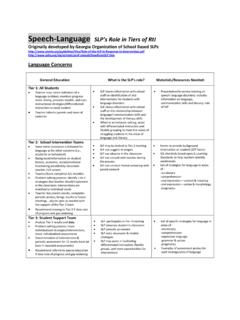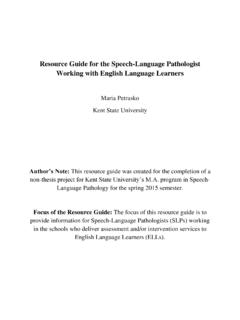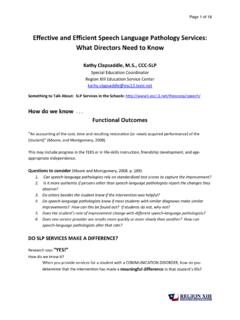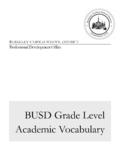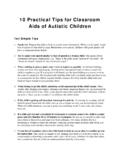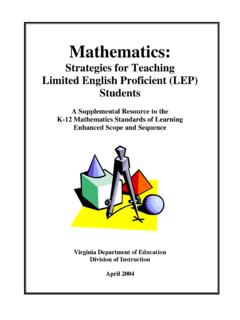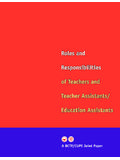Transcription of M-DCPS ESOL Strategies Matrix PartA
1 APPENDIX A 1 ESOL Strategies Matrix Category Alpha Numeric ID Strategies /Resources A. Listening A1 LEA ( language Experience Approach) A2 Modeling A3 Teacher Lead Groups A4 Total Physical Response (TPR) A5 Use Illustrations/Diagrams A6 Use Simple, Direct language A7 Use Substitution, Expansion, Paraphrase, and Repetition.
2 B. Speaking B1 Brainstorming B2 Cooperative Learning (Group Reports/Projects) B3 Panel Discussions/Debates B4 Provide Meaningful language Practice B5 Repetition B6 Role-play B7 Teacher-Led Groups B8 Teacher/Student/Modeling B9 Think Aloud C.
3 Reading C1 Activate Prior Knowledge C2 Picture Walk C3 Prediction C4 K-W-L (Know/Wants to Know/Learned) C5 Question-Answer-Relationship (QAR) C6 Use Task Cards C7 Teacher Made Questions C8 Vary the complexity of assignment (Differentiated Instruction (DI)) C9 Read Aloud (RA) C10 Choral Reading C11 Jump In Reading C12 Reader s Theater C13 Cooperative Learning C14 Chunking C15 Explain Key Concepts C16 Focus on Key Vocabulary C17 Vocabulary with Context Clues C18 Vocabulary Improvement Strategy (VIS)
4 C19 Use Multiple Meaning Words C20 Interactive Word Walls C21 Use Of Cognates C22 Word Banks/Vocabulary Notebooks APPENDIX A 2 C23 Decoding/Phonics/Spelling C24 Unscramble: Sentences/Words C25 Graphic Organizers C26 Semantic Mapping C27 Timelines C28 Praise-Question-Polish (PQP) C29 Visualization C30 Reciprocal Teaching C31 Context Clues C32 Verbal Clues/Pictures C33 Schema Stories C34 Captioning C35 Venn Diagrams C36 Story Maps C37 Structural Analysis C38 Reading for a Specific Purpose C39 Pantomimes/Dramatization C40 Interview C41 Retelling C42 Think/Pair/Share C43 Dictation C44 Cloze Procedures C45 Graphic Representations C46 Student Self Assessment C47 Flexible Grouping C48 Observation/Anecdotal C49 Portfolios C50 Wordless/Picture Books C51 Highlighting Text C52 Note-Taking/ Outline Notes C53 Survey/Question/Read/Recite/Review (SQ3R)
5 C54 Summarizing C55 Buddy/Partner Reading C56 Collaborative Groups C57 Pacing of Lessons C58 Exit Slips C59 Sustained Silent Reading (SSR) D. Writing D1 Dialogue Journals D2 Graphics Organizers D3 Illustrating and labeling D4 Letter Writing D5 Personal Journals APPENDIX A 3 D6 Process Writing D7 Reading Response Journal/Log D8 Rubrics Writing Prompts
6 D9 Spelling Strategies D10 Summarizing D11 Writing Prompts D12 Writing Sample E. Audio Visuals E1 Audio Books E2 language Master E3 Videos/CD s/Cassettes E4 Music/Chants/Raps E5 Listening Centers E6 Technology/Computer Software E7 Realia (concrete objects)/Manipulatives E8 Visuals (Charts/Pictures/Graphs) F.
7 Multicultural Resources F1 Cultural Sharing F2 Guest Speakers F3 Worldwide Holiday Activities G. Instructional Modifications/ Assessment Accommodations G1 Heritage language /English Dictionary G2 Extended Time G3 Flexible Setting G4 Flexible Scheduling APPENDIX B 1A. Listening A1. LEA ( language Experience Approach) The goal of the language Experience Approach (LEA) is to have students produce language in response to first-hand, multi-sensorial experiences. The LEA uses the students ideas and their language to develop reading and writing skills.
8 Steps for using the language Experience Approach in the classroom: Step 1: Providing the Experience/Motivation An experience story is based on an experience the teacher and students share. Step 2: Facilitation language Production Immediately following an experience, students need to interact with each other to discuss the experience and what it meant to them. Step 3: Creating a Personal View Representation The teacher has the student draw or paint a picture about something interesting about the activity. Step 4: Retelling Events/Reactions A volunteer is selected to share his or her picture with the group. Step 5: Writing Student s Statements The teacher asks each student a question and records his/her answer, writing on the chalkboard exactly what the student says, using large manuscript letters.
9 After writing each statement, the teacher reads it back to the group for confirmation. When four or five statements are on the board, the students decide their sequential ordering. The statements are then numbered and transferred to a sentence strip, and the students correctly arrange the strips on a chart holder. Step 6: Reading After the chart or individual statements have been completed, students read their statements to each other and to the teacher. Step 7: Writing As students develop writing skills, they copy the story into their notebooks or on lined paper. Step 8: Follow Up with Activities The story may be reread on several subsequent days either by the teacher, the students, or both. Students can also save the story with other language experience class stories to form their own class book for later reading.
10 A2. Modeling The teacher demonstrates to the learner how to do a task, with the expectation that the learner can copy the model. Modeling often involves thinking aloud or talking about how to work through a task. A3. Teacher-Led Groups Teacher-led groups are the most common configuration used in classrooms today. They include whole-class, small group, and individual instruction. In general, communication paths in teacher-led groups are almost exclusively between teacher and student. Teacher-led groups are an effective and efficient way of introducing material, summing-up the conclusions made by individual groups, meeting the common needs of a large or small group, and providing individual attention or instruction. Whole-Class Instruction: Whole-class instruction is often used to introduce new materials and Strategies to the entire class.

